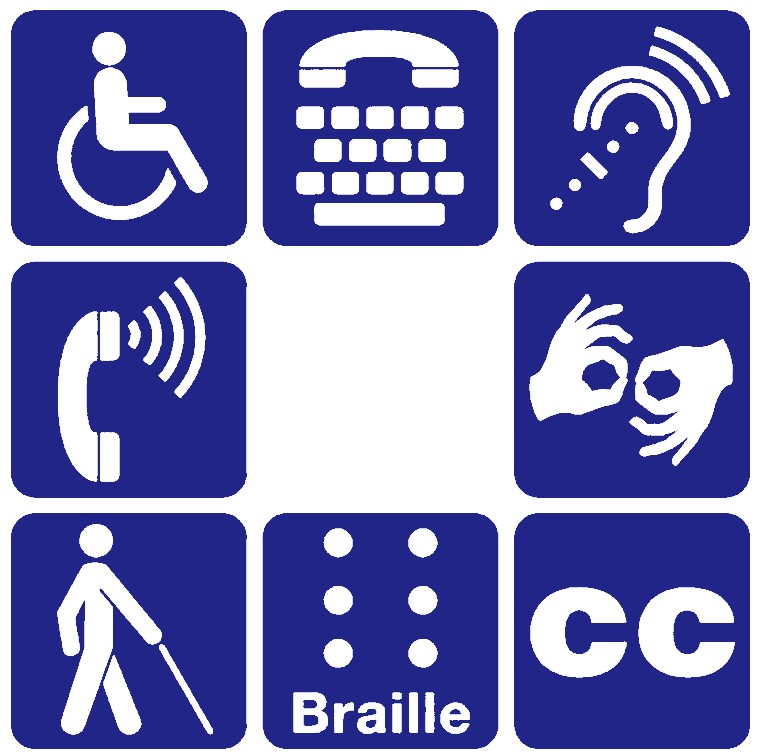What is
the ADA?
The Americans with Disabilities Act (ADA) passed on July 26, 1990. It provides a legal framework for people with disabilities to challenge discriminatory practices in work settings, state and local government, and places of public use. Under the ADA, disability is formally recognized as a source
of discrimination, similar to how “race, color, religion, sex, or national origin” is recognized by the Civil Rights Act of 1964. The ADA’s importance extends well beyond the court system. The ADA is also a broader symbol of bipartisan support for disability inclusion in all parts of public life. The larger goal of the law is to assure equality of opportunity, full participation, independent living, and economic self-sufficiency for all individuals with disabilities.
Research
Highlights
Small business employers often have concerns about the
cost of accommodations and healthcare for employees with
disabilities.
Training and education that includes resources about actualized costs and benefits of ADA implementation is important for small businesses.
Accommodations for employees are often inexpensive and can improve access for customers.
Hiring people with disabilities can improve customer relationships and open new markets.
28.8
MILLION
Small Businesses in the U.S.
with fewer than 500 employees
These small businesses...
Employ 56.8M people
48% of the private workforce
make up 99.7% of all employers
account for 63% of new job creation
56.7
MILLION
People with Disabilities in U.S.

facing significant employment disparities
51% are working age (18-64 yrs)
In 2016, the disability employment rate was 35.8% compared to 76.6% for the general population.
The employment gap has been above a 40% difference since 2010.
Research on Employees with Disabilities
in Small Businesses
Research on the ADA has focused on employees in larger settings, whereas studies looking at employees in small businesses often do not look at the ADA.
1
Return on Investment
through increased revenue, reduced costs, and enhanced shareholder value.
2
Human Capital
strategies allow businesses to profit from a diverse talent pool.
3
Accessing New Market Opportunities
by tapping into the disability market and developing new products or services that respond to marketplace need.
4
Diversity
benefits businesses both through having a diverse workplace and expanding to reach a diverse marketplace.
5
Social Responsibility
that increases value in the market as well as in the workplace.
6
Innovation
as employees unique experiences can lead to innovative workplace solutions, products or services, and future directions.
75%
of employees with disabilities have marketable ideas that could contribute to the value of the business.
48%
report that their ideas went ignored.
ATTITUDES
BEHAVIORS
Dual Focus of Employer Research
TITLE I
of the ADA prohibits employers from discriminating against qualified individuals on the basis of disability from the application process to hiring, advancement, compensation, job training opportunities, and even the firing process.
Attitudinal research on employers and the ADA is inconsistent.
Research on “knowledge about the law” is often used to interpret employer behaviors, with few studies examining employer behaviors directly.
While the ADA has addressed significant barriers in disability employment, employee concerns can be barriers to implementation:
Focusing on compliance that does not necessarily lead to inclusion.
Fear of litigation getting in the way of encouraging open dialogue.
We keep assuming success of the ADA will be driven by employer attitudes. But research has not yet proven that positive attitudes actually lead to increased hiring of people with disabilities.
REASONABLENESS OF ACCOMMODATIONS
Employer’s concerns about the reasonableness of an accommodation (and how much it may cost) affects their willingness to hire people with disabilities.
BUT employers' perceptions of the cost do not match up with the reality of providing them.
50% of people with disabilities need accommodations in the workplace.
The average cost of accommodations is $500, but 59% of accommodations did not cost anything.
Small businesses are less likely to need to provide accommodations than larger businesses.
Small businesses are more likely to spend money accommodating customers with disabilities.
Customers with Disabilities
TITLE III
of the ADA prohibits discrimination on the basis of disability in activities that are available to the general public, such as in theaters, restaurants, recreational facilities, medical facilities, schools, day cares etc.
PUBLIC ACCOMMODATIONS
As members of the public, the ADA requires small businesses to make public accommodations for people with disabilities by removing architectural barriers and becoming accessible.
Title III of the ADA helps to ensure that all customers, regardless of disability, can access the same goods and services.
The cost of removing architectural barriers can be larger for small businesses than larger businesses.
2.2 to 4.1 times greater per square foot
Serving customers with disabilities will increase those businesses' customer base.
Businesses can benefit by listening to customers with disabilities about their preferences, desires, and requirements leading to innovation in:
Product development
Customer service strategies
Marketing strategies to boost their bottom line
87%
of customers stated that they are more likely to shop at businesses where people with disabilities are employed.
THE ADA HAS CHANGED THE MODERN WORKPLACE
EXAMPLES FROM
ADA National Network
Below are examples from the ADA Centers who provide tailored information, guidance, and training on the ADA as it relates to small businesses.
PLANNING FOR ACCESSIBLE DESIGN
Some states have additional accessibility guidelines, and small businesses need to be compliant with both these requirements as well as the ADA Standards for Accessible Design.
Technical assistance specialists at ADA Centers have used their knowledge of both state and federal guidelines to help small businesses by reviewing architectural plans and offering suggestions to enhance accessibility for customer with disabilities.

IDENTIFYING BARRIERS TO PHYSICAL ACCESS
One ADA Center worked with a small bookstore that was interested in increasing access for customers with disabilities.
A technical assistance specialist visited the bookstore and identified opportunities to enhance access.
The store owner rearranged bookshelves within the building and purchased a portable ramp with an intercom system, so persons requiring the ramp could contact staff for assistance.

HELPING TO ENSURE COMPLIANCE
Another ADA Center received a request to make an onsite visit to a medical supply business to recommend changes regarding physical access to the building.
The technical assistance specialist made suggestions about entry doors, curb ramps, and parking lot compliance issues.
Based on these recommendations, the business reconstructed and the whole building is now accessible.

MEDIATING ADA COMPLAINTS
A restaurant that had opened in an existing building reached out to one of the ADA Centers because a customer had threatened to sue due to inaccessibility.
The ADA Center explained the ADA requirements for accessible space in existing buildings and ongoing requirements to ensure barrier removal.
The ADA Center worked with the small restaurant and a few months later they added a ramp at the front entrance and a new deck that was accessible for everyone.

FOR MORE INFORMATION CONTACT:
This information product was developed under a grant from the Administration for Community Living (ACL) NIDILRR grant number 90DP0086. However, the contents do not necessarily represent the policy of ACL and you should not assume endorsement by the Federal Government.
SUGGESTED CITATION: Gould, R., Parker Harris, S., Caldwell, K. & Mullin, C. (2018). ADA Research Brief: Small Business and the ADA (pp. 1-3). Chicago, IL: ADA National Network Knowledge Translation Center.

.png)









